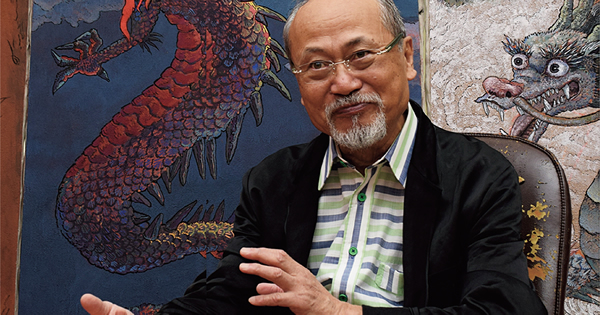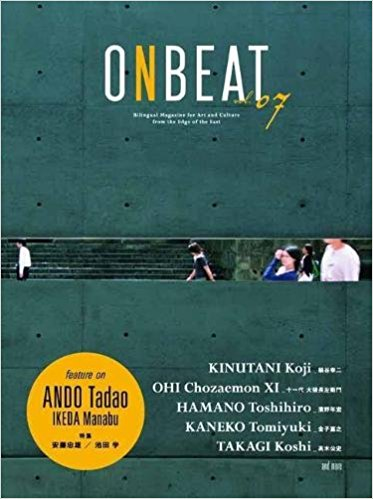2017/08/19
<インタビュー>絹谷幸二 色彩とイメージの旅 | <Interview>Koji Kinutani A Journey of Color and Imagery

この夏、京都国立近代美術館で大規模な個展を開催する画家・絹谷幸二。「色彩とイメージの旅」と題された同展覧会は、絹谷幸二の初期から現在に至る代表作と共に、京都を題材とした新作などを展示し、その活動の全貌に迫るものになるという。アフレスコ技法による色彩豊かで、エネルギーに満ち溢れた画面によって独自の画風を確立した絹谷が、作品に込められたメッセージや、同個展に対する思いを熱く語った。
A big exhibition of the painter Koji Kinutani will take place this summer in National Museum of Modern Art, Kyoto. Along with important works spanning the artist's career and never-before-shown works on the theme of Kyoto, this exhibition"A Journey of Color and Imagery" presents the entire scope of Kinutani's manifold practice. Establishing a unique style with colorful and highly energetic fresco works, Kinutani passionately talks about the message in his artworks and his feelings for the exhibition.
京都国立近代美術館で開催される個展は、「色彩とイメージの旅」というタイトルですが、それすなわち絹谷先生が追い続けてきた制作テーマなのではないでしょうか。
Your exhibition at the National Museum of Modern Art, Kyoto (MoMAK) is titled "A Journey of Color and Imagery." Isn't this pre- cisely the theme you have pursued in your art?
そのとおりです。「色彩」に関しては、 東京藝大の学生時代、僕はいわゆるモノクローム調の地味な絵ばかり描いていました。ところが留学先のヴェニスのサ ンタ・ルチア駅に降りた途端、心が開かれるような世界に遭遇したのです。ヴェニスの街の色彩と地中海の明るい色彩に胸襟が開かれる思いがしました。しかし、そ のとき同時に「待てよ、こういう景色はどこかで見た気がする」と感じ、よくよく思い起こせば、私の生まれた奈良のかつての姿がそれなんですね。今の奈良は侘び寂び調になっていますが、奈良が「都」として一番栄えていたころは、「咲く花の 匂うがごとく、 いま盛りなり」と謳われる色彩感に溢れた、そして心も胸襟も開いた世界だったんです。バラモン宗の人が歩いていたり、イラン、イラクの人や、中国、朝鮮の人がいたりと、非常に国際的な都市でした。思いもかけず、私はヴェニスで己のルーツ、奈良を再発見したのです。日本人は元々海洋民族ですから、もっと明るい国民性があるのですが、徳川300年の軍事政権の間に庶民はかなり抑えつけられ、侘び寂び的な価値感を植えつけられてきました。その影響がまだ日本人の中に残っている。色彩が抑えられた環境では、例えばみんなでカーキー色の服を着れば、簡単に他人を殺せるようになります。
「みんなで渡れば怖くない」という「右向け右」、「横並び」の思考です。個性を抑えつけず、日本人にそれぞれの持ち味を発揮してもらうためにも、僕は日本に本来の色彩を取り戻したいという思いがあります。砂漠や海底30mといった色彩の乏しい環境では、生き物の多様性も一気に減ります。色彩がある場所は、命溢れる平和な場所でもあるんです。一方で、「イメージ」というのは「夢」、あるいは 「想 像力」、「空想力」と言ってもいいですが、それは取り出して見せることができない「触れられない世界」、「心の中の世界」です 。 僕は「イメージ 」は、無くてはならない一番大事な感覚だと思う。数字で表すことができないからです。産業 革命以来、 数字や物質をずっと追い続けてきた結果、世界中で戦争が起こり、物質偏重社会となり、「イメージ」という「触れられない世界」は疲弊してきています。こういった今の世界を変えなきゃいけない、というのが私の本心です。日本の 国も人々が色とりどりに個性を伸ばし、それぞれが持つ「イメージ」を発揮していただければ、今までとは違った広がりをもって伸びるのではないかなという考えもあり、絵描きである自分は、作品を通じてそうした思いを表現してきました。
Exactly. In regards of "color", during my time as student at the Tokyo University of the Arts, I had always painted mono- chromatic works. However, when I was studying in Venice, I walked out of Santa Lucia Railway Station and encountered an eye-opening world. The bright colors of the Venetian townscape and the Mediterranean Sea opened up my heart. At the same time, however, I realized that I have seen this scene before. I thought harder and remembered that my hometown Nara used to be such a place in the past. Nara has a subdued atmosphere of quiet simplicity today. But back in the time when Nara was the capital of Japan, it was a colorful, open place just as it was praised in a famous poem: "As flowers in bloom glow in beauty and fragrance, the capital at Nara is now at the height of its splendor."* Nara was a cosmopolitan city where people from Iran, Iraq, China, and Korea came and exchanged cultures. In Venice, I had unexpectedly found my roots in Nara. The Japanese people, being originally maritime people, had a brighter character. Three-hundred-years of military regime under the Tokugawa government had suppressed such brightness. The influence continues to today. In an environment where colors are limited, a follow-the-crowd mentality grows. For instance, if everyone wears khaki, killing people can become easy all of the sudden. In natural environments such as deserts and the deep sea, the diversity of animals become limited. A colorful place is a place of life and peace. I would like to bring back the real color of Japan so that the Japanese people can be who we truly are. On the other hand, the world of "imagery" - which we can also refer to as dream, fantasy, or imagination - is an untouchable world that only lives within one's heart. I believe the power of imagination is one of the most important senses we possess. The reason is because images cannot be quantified into numbers. After the Industrial Revolution, people have pursued numbers and matters causing wars all over the globe. The world became heavily reliant on materials and the "untouchable" world of "imagery" became impoverished. We must change this world. Japan and the Japanese people should cultivate our uniqueness and put each of our "imageries" into life. I believe that that will broaden our world. As a painter, I have tried to express this idea through my works.
絹谷先生の作品には、「見る人たちの自由な発想力や生命力を呼び覚ましたい」という願いたが込められているのですね。
So your intention is to wake up the viewer's power to live and create through your world of"color"and"imagery"?
そう願っています。「絵」というのは僕が死んでからも残りますから、未来の子供たちと「こういうイメージの世界もあるんだよ」ということを、絵を通じて対話できたら嬉しいですね。自分が生きているこの現代だけでなく、自分が存在していな かった過去のこと、あるいは存在しなくなった未来のことまでも含めたスパンで物 事を考えたいという思いが、僕にはあるんです。人間というのは、今のようにコン ピューター文明がどんどん進んでいっても、アルタミラの洞窟で壁画を描いていた昔から大して変わらない部分があると思います。僕たちの遺伝子の臍の緒は、洞窟壁画やフレスコ画が描かれた時代からずっとつながっていて、そういう忘れ去られた過去にこそ、これからの時代を生きていくための新しいコンセプトがあると僕 は思っています。ピカソやマティスといった画家たちも、産業革命から始まった近代化の行く末を案じ 、「古代に還れ」「自然に還れ」という思想の下、アフリカの原始美術などを発見しています。僕も未来に向かう進出の気持ちを持ちつつ、過去と何ら変わらない世界があるのだということを作品の中で指し示したいと思っています。同時に、戦争と平和、男と女、水と油など、相反する概念はひとつの絵 のように、ひとつのものの中の部分なのだということも知らしめたい。例えばミケランジェロの有名なシスティナ礼拝堂の天井図。そこには天国と地獄が描かれています。天国も地獄もひとつの絵の中の「部分」なのです。そう考えると、私たちは平和なときには悲惨な戦争のことに思いを馳せなきゃいけないし、悲惨なときには明るい世界のことを思い描く必要がある。殺し合いが絶えない現代世界の業火の中 にも"仏様"というイメージの世界が広がっていて、私たちに救いの手を差しのべて救ってくださる。相反するものは別々に存在するのではなく、いずれも「部分」に過ぎないことを、僕は絵の中で主張していきたいと思っています。
That is what I hope for. My paintings will survive long after I die. I hope to communicate with the children in the future through my works by showing them that such world of imagery exists. I hope to think not just about the present that I live in, but also about the past when I did not exist, and the future when I will no longer exist. However far technology advances, I believe that there is something inside us that will never change from the time when we painted on cave walls in Altamira. Our DNA is connected and passed on through the ages of cave paintings and fresco. I think that we can find new concepts in the forgotten past. Artists such as Picasso and Matisse feared the future of modernism that had started with the Industrial Revolution, and with the slogan "Return to ancient times" "Return to Nature", they discovered primitive art in Africa. Without forgetting the feeling of going forward, I too would like to show in my works that there is a world that never changes. At the same time, I want to show that conflicting concepts like war and peace, men and women, water and oil are all part of one thing. For instance, Michelangelo's famous painting on the ceiling of the Sistine Chapel depicts both heaven and hell. Heaven and hell are both "part" of the same painting. In times of peace, we must think of the tragedies of war, and in times of sorrow we must remember the brighter world. In the hell fire of massive killing in today's world, there is still the image of "Buddha" that extends his hand towards us. I would like to show in my paintings that conflicting things don't exist in different worlds but are merely parts of the same thing.
絹谷作品の大きな特徴として、「生命讃歌」とも言える躍動感溢れる命の描写が挙げられると思います。「命への想い」、それはどこから来るのでしょう?
I think one of the biggest features of your works is the praise of life. Where does your attachment to the theme of life come from?
小さいときに体が弱かったせいかもしれませんね。結 核とか肋膜(炎)で死にかけましたし、溜池で溺れたりしているんです。本当に龍神様に助けられたという気が します。その後も危ないことをたくさん経験しましたので、本当に今、生かされているという感謝の気持ちがあります。
It may be because I was very weak as a child. I almost died from tuberculosis and pleurisy and had also almost drowned in a reservoir once. I truly believe that I was saved by the dragon god. I have had dangerous experiences since then too so I really feel like I am being "kept alive" now.
京都国立近代美術館での 個展開催は大規模なもの になるそうですが、改めて本個展に寄せられる思い をお聞かせください。
You are now preparing for the "Koji Kinutani - Journey of Color and Imagery" at the National Museum of Modern Art in Kyoto in which you will present your entire career. What are your feelings for this exhibition?
故郷の奈良に近い京都で展覧会をやらせてもらえる ということで大変光栄に思っています。伏見稲荷大社、金閣寺、平等院、上賀茂神社、くろ谷さ ん( 金 戒 光 明寺)など、おひざ元の京都を描いた新作を多数出品いたしますので、当初は「京を描く絹谷幸二展」という題にしようと思っていたのですが、最終的に「色 彩とイメージの旅」という題に決めました。展覧会初公開作品や、初期から現在までの代表作なども多数展示されます。大阪に開館した「絹谷幸二 天空美術館」と、両方あわせてご覧いただければ有難いなと思っております。
I feel honored to be able to have my exhibition in Kyoto which is close to my hometown Nara. Because I will exhibit many pieces that features sceneries of Kyoto such as Fushimi Inari Shrine, Kinkaku-ji Temple, Byodoin Temple, Kamigamo Shrine, Konkai Komyo-ji Temple, I first thought of calling the exhibition "Koji Kinutani paints Kyoto." But in the end, I decided to use the title, "Journey of Color and Imagery." As well as new pieces, important works from my early days up to today will be on exhibition. I would be grateful if people will enjoy this exhibition along with the Koji Kinutani Tenku Art Museum in Osaka.
<Other Information>
1. 本展では絹谷幸二とその次女で日本画家の絹谷香菜子との共作による200号の新作を展示。制作過程 のドキュメントが、NHK-BS放送で9月に放送予定。
2. 第17回安井賞受賞者である絹谷幸二の作品と、巨匠画家・安井曾太郎の京都国立近代美術館収蔵作品が夢の競演。
3. 連動企画として、絹谷幸二 天空美術館では傑作との呼び声も高い、絹谷幸二初期の野心作《光ふる街》を初公開、特別展示します。
1. A collaboration work by Koji Kinutani and nihonga artist Kanako Kinutani, his daughter, will also be exhibited. A documentary TV program about their creating process will be on air this September on NHK BS Channel.
2. MoMAK's collection of portraitures by Yasui Sotaro, the master painter, will be exhibited alongside works of Kinutani as special exhibition.
3. In conjunction with this Exhibition, Tenku Art Museum will hold a Special exhibition where his early fresco City of Radiant Light will be exhibited for the first time.
2017年8月22日発売のONBEAT Vol.07(出版社:株式会社 音美衣杜[ http://onbeat.co.jp ] )の出版記事をもとに、展覧会会場写真(写真家:吉田亮人[http://www.akihito-yoshida.com] )を加えて編集しております。

ONBEAT 特徴: 日本ならではの芸術文化を、美術を中心に、音楽、ファッション、建築など人が生み出す表現をすべてアートと捉え、完全和英併記で世界に発信するバイリンガル・アート・マガジン。クリエイター達の創造の核心に迫るインタビュー記事も豊富に紹介。
The ONBEAT magazine and its website will introduce various arts and cultures all around the world as well as Japanese art and culture to the world.